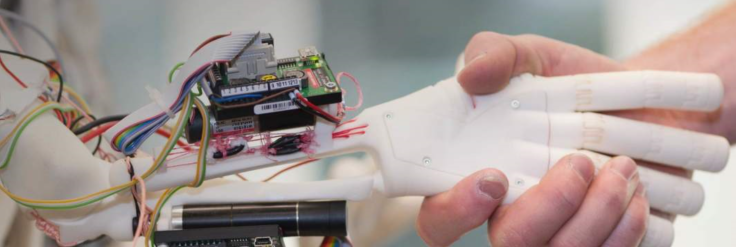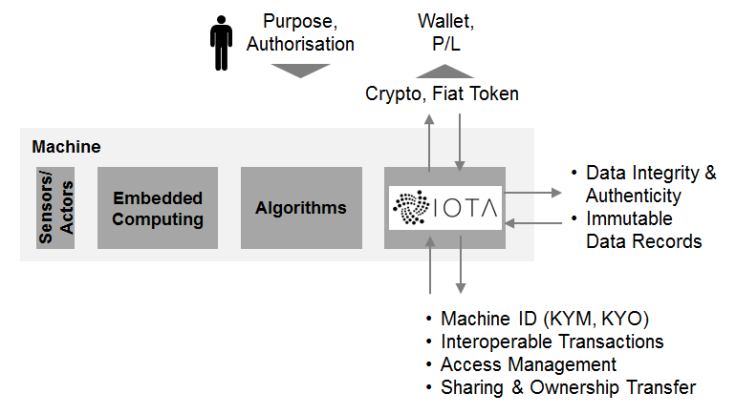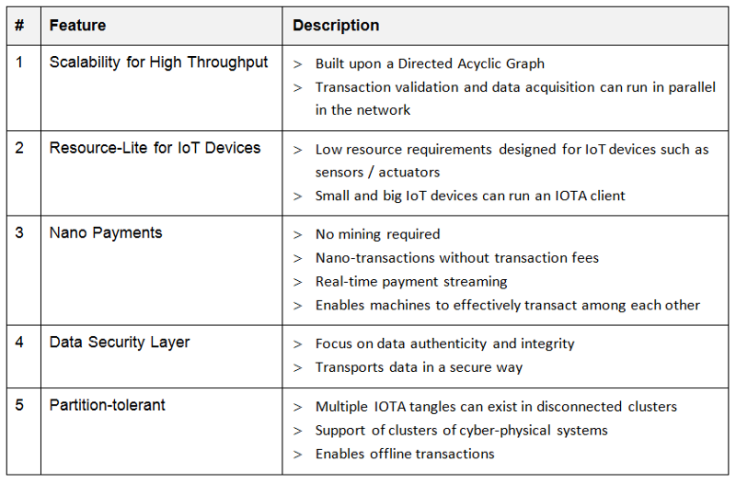Blockchain and IoT: Automating machine transactions in the fourth industrial revolution
Dr Carsten Stöcker of the innogy Innovation Hub explores IOTA for the machine economy.

Historically, trust has been "added on" to products or transactions as they flowed through a value chain for physical goods or services. Physical, or electronic, records trail every object to prove its origin, destination, quantity and history. Producing, tracking and verifying all this information imposes a massive "trust tax" of time and manual effort on banks, accountants, lawyers, auditors, quality inspectors and support functions. Important information is lost, inaccessible or even intentionally hidden.
As the fourth industrial revolution unfolds, blurring the line between the physical and digital worlds, blockchain is emerging to significantly improve authenticity and integrity of data to follow physical objects or services and guide them through the entire value chain. When combined with cryptographically secure machine identities, blockchain will create truly reliable and immutable records to make it easier and less expensive for suppliers and customers to transact with one another in a verifiable way.
In addition, a blockchain platform provides an interoperable transaction layer where previously unknown parties can dynamically start exchanging financial and physical values "on the fly". Blockchain embeds a wallet into machines. As a consequence machines are getting their own profit and loss statement and the ability to do transactions with other (machine) entities in an automated way. New machine-centred business models and forms of value exchange are now emerging very fast.
However, today's blockchain technologies have clear limitations regarding scalability, computing resource requirements and transaction fees.
The innogy Innovation Hub is now starting to explore a new technology called the IOTA tangle. The IOTA tangle goes far beyond one-dimensional blockchain concepts with a completely new architecture. It is not just another blockchain idea. It can be understood as a well-engineered new technology concept that can be a key enabler of the machine economy.
A novel approach to blockchain
IOTA tangle technology was designed to meet the requirements of machines and their IoT transactions. Its architecture is based on cryptographically secure algorithms and a protocol layer that focuses on validating transactions in a Directed Acyclic Graph structure (DAG).
IOTA Directed Acyclic Graph

A real peer-to-peer network – by machines for machines without any transaction fees
One of the main differences of the IOTA tangle, compared to conventional blockchains, is that there is no longer a concept of "miners" or a group of dedicated validators. Instead of achieving consensus through an expensive and rigorous mechanism, which ultimately leads to centralisation (as can be seen in Bitcoin), in IOTA each network participant is active in the consensus and the validation of transactions. When a device makes a transaction and broadcasts the transaction to the network, by protocol or 'by default' it has to validate two previous transactions. So it's a real peer-to-peer network by machines for machines.
This novel approach to achieving consensus in a distributed ledger has visible advantages: decentralisation, scalability and no transaction fees. The choice of using a DAG (Tangle) instead of a blockchain also has another major difference – partition-tolerance. Blockchain has the concept of a global state, where each network participant must be in full synchronicity in order to make a transaction. The IOTA Tangle is designed less rigorously, enabling the network to build clusters and even make transactions in an offline environment. This is key in mimicking the Internet of Things (IoT), where devices use different networking protocols (eg. ZigBee, Bluetooth LE, LPWAN, Lemonbeat, etc).
High-throughput
IOTA tangle provides an architecture in which transactions can be validated in parallel. This architecture is the basis for pushing the limits of today's blockchains regarding transaction throughput. Instead of being limited to sequential blocks being added to a chain, in IOTA, scalability and adapting to high-throughput environments where devices make thousands of transactions is the norm. As such, IOTA is the first permissionless distributed ledger that achieves scalability, making Machine-to-Machine payments for the IoT possible.
The current IOTA Tangle has been stress tested by its developers to perform the highest number of transactions per second of any other blockchain technology with a cluster of several hundred nodes making transactions simultaneously. The number of transactions per second scales in proportion of the network. A public stress test on the permissionless ledger is currently being planned by the IOTA Team for end of Q1/2017 (Source: IOTA Team).
Truly economically viable nano-transactions
In an IoT world of machines doing transactions among each other, there will be huge volumes of nano- and micro-transactions. Intelligent devices will exchange small and big-data packages, small and big amounts of energy – or any other resource (e.g. bandwidth, computation, storage etc) – , provide (micro-)services and exchange physical objects along a dynamic supply chain.
Almost zero transaction fees as enabler for huge amounts of nano-transactions
These so called cyber physical systems require the ability to perform nano- and micro-transactions with almost zero or zero transaction fees, otherwise it's no more economically viable. IOTA was designed with automated machine transactions in mind to transfer crypto-tokens at zero transaction fee enabling an economically viable Cambrian Explosion of nano- and micro-transactions.
We expect that many cyber physical system such as supply chains, mobility systems, smart cities or health care systems will emerge and be built upon automated bots and Artificial Intelligence / Machine Learning (AI/ML). These systems can be loosely connected clusters of machines or integrated systems.
Secure Data Transport and Transaction Layer
The lack of transaction fees enables new data-driven business models. For example, two parties, Alice and Bob, agree on a value of data sets in a data stream. As data sets are sent from Alice to Bob, Bob sends a nano-payment (in the form of tokens) to compensate in real time Alice, who is able to sell the data at no credit risk.
Data will be signed and hashed by an IOTA node. Signatures and the immutable hash values assure Bob that he can rely on the authenticity and integrity of the data.
The IOTA data security and transport layer brings data acquisition and control applications to an entirely new level for energy management, supply chain management, mobility logistics telematics, health care telematics, environmental observation, security and (meshed) telecommunication networks.
Economically Independent Machines
By adding an IOTA node, a machine will be transformed into an 'economically independent machine' with its ability to transact with other machines and to manage its own profit and loss statement.
In the near future, as a consequence, we can expect that a machine will be able to pay its assembly, its maintenance, its energy and also for its liability insurance by giving data, computing power, storage or physical services to other machines. For the first time in history, a device will be in a position to earn and spend money on its own. At this point a machine turns into an entity that tracks revenue and expenditure from its own activities.

Economically Independent Machines with IOTA NodeToday, we have "unbanked" machines with limited possibilities to participate in economic activities, as no traditional bank is willing to give a bank account to a machine. Now, devices can achieve self-sovereignty by owning their wallet to store digital currency. Income is generated by a machine through physical or data services without any middleman and can be used for purchases like insurance, energy or maintenance.
These scenarios are possible with IOTA. When tracking the identity of machines, "know your customer" (KYC) – which is the main criteria for a bank to provide a bank account to a customer – is also applied to machines: "Know your machine" (KYM) or "Know your object" (KYO) is the beginning of self-sovereignty for machines.
IOTA offers a unique set of distinctive features to machines that sets it apart from other blockchain technologies.
IOTA Features

Slashing the trust tax
IOTA and innogy are now moving into a joint project partnership for prototyping and testing initial use cases with the ultimate goal to slash the "trust tax" and to monetise new forms of value exchange in the machine economy.
We let physical objects trail with an IOTA node through the supply chain providing "trust into data" they generate. These data sets will be automatically tracked and verified by the IOTA tangle along both the supply chain and the machine life cycle.
Transparency along the Machine Life CycleTagging an object with an IOTA node at its creation including the data about its creation establishes the foundation for an interoperable 'Digital Twin' with full "back-to-birth-traceability".
We are now looking into concepts of the fourth industrial revolution with "machine / supply chain transparency by design" strongly connecting physical and digital worlds. Important information should never be lost, inaccessible or even intentionally hidden again.
IOTA-enabled "distributed trust" will drive entire new business models such as dynamically defined on-demand markets for services and physical products or data services using IOTA to sell data-driven insights in areas such as supply chains, mobility, security or environment observation. "Asset-less" enterprises will emerge that rely on third-party assets, verifying their work with blockchain-enabled transparent and credible supply chain data.
© Copyright IBTimes 2025. All rights reserved.





















